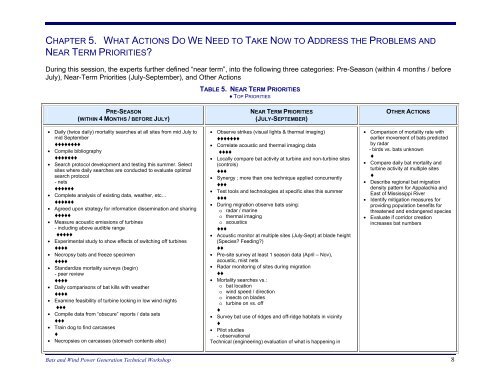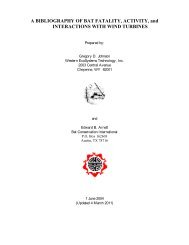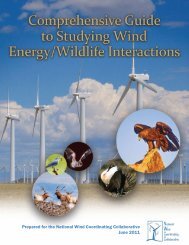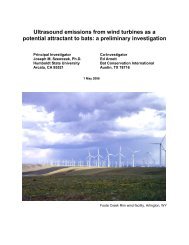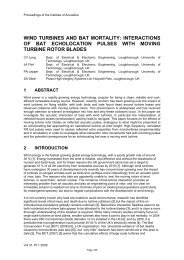Proceedings of the 2004 Bats and Wind Power Generation ...
Proceedings of the 2004 Bats and Wind Power Generation ...
Proceedings of the 2004 Bats and Wind Power Generation ...
You also want an ePaper? Increase the reach of your titles
YUMPU automatically turns print PDFs into web optimized ePapers that Google loves.
CHAPTER 5. WHAT ACTIONS DO WE NEED TO TAKE NOW TO ADDRESS THE PROBLEMS ANDNEAR TERM PRIORITIES?During this session, <strong>the</strong> experts fur<strong>the</strong>r defined “near term”, into <strong>the</strong> following three categories: Pre-Season (within 4 months / beforeJuly), Near-Term Priorities (July-September), <strong>and</strong> O<strong>the</strong>r ActionsTABLE 5. NEAR TERM PRIORITIES♦ TOP PRIORITIESPRE-SEASON(WITHIN 4 MONTHS / BEFORE JULY)• Daily (twice daily) mortality searches at all sites from mid July tomid September♦♦♦♦♦♦♦♦• Compile bibliography♦♦♦♦♦♦♦• Search protocol development <strong>and</strong> testing this summer. Selectsites where daily searches are conducted to evaluate optimalsearch protocol- nets♦♦♦♦♦♦• Complete analysis <strong>of</strong> existing data, wea<strong>the</strong>r, etc…♦♦♦♦♦♦• Agreed upon strategy for information dissemination <strong>and</strong> sharing♦♦♦♦♦• Measure acoustic emissions <strong>of</strong> turbines- including above audible range♦♦♦♦♦• Experimental study to show effects <strong>of</strong> switching <strong>of</strong>f turbines♦♦♦♦• Necropsy bats <strong>and</strong> freeze specimen♦♦♦♦• St<strong>and</strong>ardize mortality surveys (begin)- peer review♦♦♦♦• Daily comparisons <strong>of</strong> bat kills with wea<strong>the</strong>r♦♦♦♦• Examine feasibility <strong>of</strong> turbine locking in low wind nights♦♦♦• Compile data from “obscure” reports / data sets♦♦♦• Train dog to find carcasses♦• Necropsies on carcasses (stomach contents also)NEAR TERM PRIORITIES(JULY-SEPTEMBER)• Observe strikes (visual lights & <strong>the</strong>rmal imaging)♦♦♦♦♦♦♦• Correlate acoustic <strong>and</strong> <strong>the</strong>rmal imaging data♦♦♦♦• Locally compare bat activity at turbine <strong>and</strong> non-turbine sites(controls)♦♦♦• Synergy ; more than one technique applied concurrently♦♦♦• Test tools <strong>and</strong> technologies at specific sites this summer♦♦♦• During migration observe bats using:o radar / marineo <strong>the</strong>rmal imagingo acoustics♦♦♦• Acoustic monitor at multiple sites (July-Sept) at blade height(Species? Feeding?)♦♦• Pre-site survey at least 1 season data (April – Nov),acoustic, mist nets• Radar monitoring <strong>of</strong> sites during migration♦♦• Mortality searches vs.:o bat locationo wind speed / directiono insects on bladeso turbine on vs. <strong>of</strong>f♦• Survey bat use <strong>of</strong> ridges <strong>and</strong> <strong>of</strong>f-ridge habitats in vicinity♦• Pilot studies- observationalTechnical (engineering) evaluation <strong>of</strong> what is happening inOTHER ACTIONS• Comparison <strong>of</strong> mortality rate wi<strong>the</strong>arlier movement <strong>of</strong> bats predictedby radar- birds vs. bats unknown♦• Compare daily bat mortality <strong>and</strong>turbine activity at multiple sites♦• Describe regional bat migrationdensity pattern for Appalachia <strong>and</strong>East <strong>of</strong> Mississippi River• Identify mitigation measures forproviding population benefits forthreatened <strong>and</strong> endangered species• Evaluate if corridor creationincreases bat numbers<strong>Bats</strong> <strong>and</strong> <strong>Wind</strong> <strong>Power</strong> <strong>Generation</strong> Technical Workshop 8


